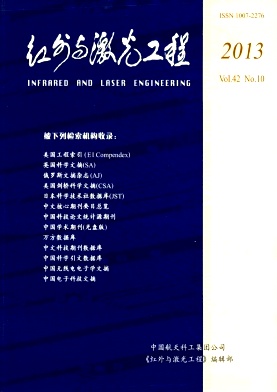Song Lin, Cheng Yongmei, Liu Nan, Liu Xialei. Algorithm of vision tracking for UAV navigation based on multi-constraint KLT[J]. Infrared and Laser Engineering, 2013, 42(10): 2828-2835.
| Citation:
|
Song Lin, Cheng Yongmei, Liu Nan, Liu Xialei. Algorithm of vision tracking for UAV navigation based on multi-constraint KLT[J]. Infrared and Laser Engineering, 2013, 42(10): 2828-2835.
|
Algorithm of vision tracking for UAV navigation based on multi-constraint KLT
- Received Date: 2013-02-17
- Rev Recd Date:
2013-03-10
- Publish Date:
2013-10-25
-
Abstract
Feature point tracking is an important technology to implement the visual odometry for navigation. Aiming at the problem of feature tracking with big errors caused by large motion of the video fixed on UAV, a multi-constraint KLT tracking strategy based on time-reversibility and bi-directional displacement constraint was proposed and the pyramid model was used for the hierarchical displacement computation of the tracking points. The new objective function was set up according to the fusion of forward and backward tracking. A new bi-directional displacement was constructed based on the displacements of forward and backward tracking, and the optimal estimation of the displacements was implemented in the structure of pyramid model. The experiment results demonstrate that the proposed algorithm improves the performance of precise tracking effectively and outperforms the similar tracker.
-
References
|
[1]
|
|
|
[2]
|
Davide Scaramuzza, Friedrich Fraundorfer. Visual odometry: part I: the first 30 years and fundamentals [J]. IEEE Robotics Automation Magazine, 2011, 11, 18(4): 80-92. |
|
[3]
|
|
|
[4]
|
Huang Kengyen, TSAI Yimin, TSAI Chihchung, et al. Feature-based video stabilization for vehicular applications[C]//IEEE 14th International Symposium on Consumer Electronics, 2010: 1-2. |
|
[5]
|
Lowe David G. Distinctive image features from scale-invariant keypoints [J]. International Journal of Computer Vision, 2004, 60(2): 91-110. |
|
[6]
|
|
|
[7]
|
|
|
[8]
|
Li Xiying, Ni Guoqiang. Optical flow computation of infrared image [J]. Infrared and Laser Engineering, 2002, 31 (3): 189-193. |
|
[9]
|
|
|
[10]
|
Muhammad Wasim Nawaz, Abdesselam Bouzerdoum, Son Lam Phung. Optical flow estimation using sparse gradient representation [C]//IEEE 18th International Conference on Image Processing, 2011: 2681-2684. |
|
[11]
|
Gianpaolo Conte, Patrick Doherty. An integrated UAV navigation system based on aerial image matching[C]//IEEE Conference on Aerospace Conference, 2008:1-10. |
|
[12]
|
|
|
[13]
|
|
|
[14]
|
Hao Wu, Chellappa R, Sankaranarayanan A C, et al. Robust visual tracking using the time-reversibility constraint[C]//IEEE International Conference on Computer Vision, 2007. |
|
[15]
|
|
|
[16]
|
Shi J, Tomasi C. Good features to track [C]//IEEE Conference on Computer Vision and Pattern Recognition, 1994: 593-600. |
|
[17]
|
|
|
[18]
|
Zdenek Kalal, Krystian Mikolajczyk, Jiri Matas. Forward-backward error: automatic detection of tracking failures [C]//International Conference on Pattern Recognition, 2010: 2756-2759. |
-
-
Proportional views

-









 DownLoad:
DownLoad: